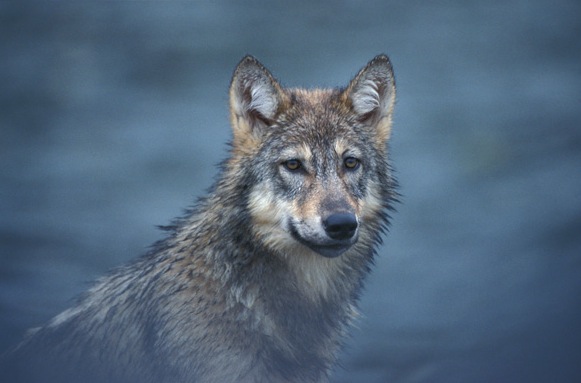
Wolves, like this young subadult, are curious, intelligent and among the most social animals on the planet.

Wolves, like this young subadult, are curious, intelligent and among the most social animals on the planet.
A Bad Rap
“Who’s afraid of the big bad wolf, the big bad wolf, the big bad wolf? Who’s afraid of the big bad wolf? Tra la la la la.” You may remember this song from when you were younger. The Three Little Pigs sang it in a Disney cartoon made way back in 1933. (You can still see it on YouTube.) In the cartoon, the wolf, who walks upright on his hind legs and wears an Abe Lincoln stovepipe hat and hillbilly britches, blows down one little pig’s house made of straw and another made of sticks. But he can’t blow down the third pig’s house because it’s made of bricks. So he scrambles up to the roof and climbs down the chimney only to be boiled alive in a cauldron of water in the fireplace. In the cartoon, the wolf manages to escape—his badly burned backside blowing a plume of smoke as he runs away. But in the original English version of the story, written more than half a century earlier, he isn’t so lucky. The pig who built the brick house covers the pot and cooks the wolf for supper.

Two siblings share an affectionate moment in some tall grass. One of these young wolves may become the leader of his pack one day, but that will depend on leadership skills and whether he wants the job.
Regardless of which version of “The Three Little Pigs” you encounter, the message of the story is clear: wolves are big, bad and dangerous—to people and pigs—and the only good one is a dead one. It’s a view many people have held for centuries. Think of the folktales you know in which wolves play a part. Then think about the parts those wolves play.
In “Little Red Riding Hood,” a German fairy tale also filmed by Disney, a wolf eats a little girl’s grandmother and then the girl herself. They’re saved, however, when a hunter cuts the wolf open and finds the little girl and her grandmother alive and whole inside. The wolf also plays the villain in “Peter and the Wolf,” a Russian story in which a young boy’s pet duck is caught and eaten by—what else?—a wolf. Then, just as in “Little Red Riding Hood,” hunters capture the wolf, tie him up and take him to a zoo in a victory parade led by the boy, Peter. At the end, the storyteller says if you listen carefully you can still hear the duck quacking because the wolf, in his greed and haste for a meal, swallowed her alive.
But our fear and loathing of wolves doesn’t end there. It shows up in sayings too. When we run short of money, we say “the wolf is at the door,” as if having a wolf at our door would be the very worst thing that could happen to us. When someone is described as being “a wolf in sheep’s clothing,” it means he or she is really no good and is only pretending to be gentle and kind. When we “cry wolf,” it means we’re lying about, or exaggerating, a situation and will be punished for it.
With so many messages around about wolves being sly, unpredictable, vicious and bloodthirsty, is it any wonder that, even in a modern, scientific and environmentally aware society such as ours, people still regard them as enemies? Or worse, as vermin—something to get rid of?

A black wolf searches for salmon on a bright fall day. Rainforest wolves come in different colors—ranging from black to white—but the most common color is brown with reddish highlights.
If you doubt that, consider that it wasn’t long ago that wolves could be found throughout most of North America. Not anymore. Outside of Alaska they have been ruthlessly exterminated from 95 percent of the places they used to live in the United States. The US government hated them so much that for over a hundred years it paid a bounty, a reward of money, to whoever killed a wolf anywhere in the country. The same thing happened in Canada. One of the first acts of the new government of Upper Canada—what is now Ontario—was to offer a cash payment to anyone who would rid the country of its wolves. Yet to this day there has not been a single documented case of a person in North America being killed by a wolf. (In 2005, a university student working in a mining camp in northern Saskatchewan was found dead with wolves observed nearby, but it has never been determined whether he was killed by wolves or a bear.)
Thankfully, wolves are still present in parts of North America. In Canada, which has far fewer people than the United States and therefore more room for wildlife, they can be found in most provinces except for parts of the Prairies and Maritimes. In British Columbia, where the wolves featured in this book live, they’re found almost everywhere except Haida Gwaii, a chain of islands off the province’s northwest coast. But even today they are under constant threat. In BC there are no real restrictions against killing them. You need a special license to hunt deer, ducks, geese, bear, moose and elk in BC. And when you kill a bear or an elk, you have to report when and where you made the kill. Not so with wolves. Officially you’re allowed to kill three a year, but if you do, you don’t have to tell anyone about it, which makes it almost impossible for anyone, including scientists, to understand the full impact hunting has on wolves.
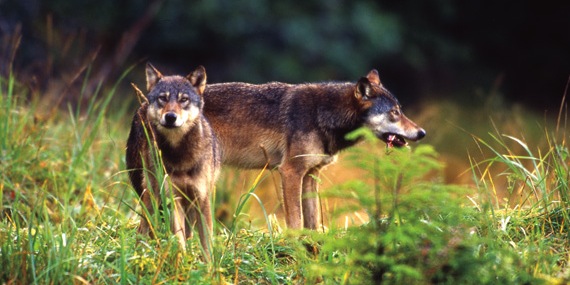
These two wolves belong to a pack conservationists have called the Fish Trap pack because it lives near an ancient First Nations fishing spot. They feed on salmon between September and November.
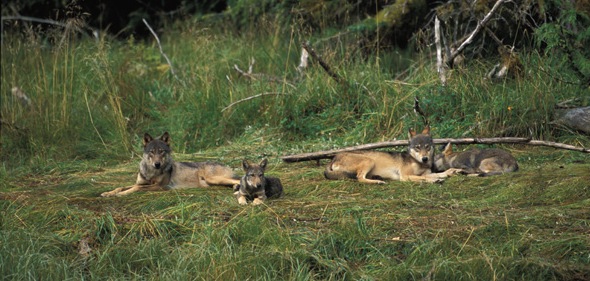
Wolves live in extended families called packs. Each pack is led by one male and one female, who also act as the breeding pair. Next to that of primates, the social structure of a wolf family is one of the most complex and evolved in the animal world.
That’s why we thought it was time a different kind of book told a different kind of story about wolves. Because if you put aside all the bad press they’ve received in North American history, European fairy tales and Disney cartoons, and you take the time to learn what they’re really like, you’ll discover that wolves are fascinating. And that the fishing, swimming wolves who live in the rainforest along BC’s central and northern coast are especially so. Yes, like all wolves, they eat other animals to live. Wolves are carnivores, meaning they need to hunt other animals to survive. And that’s not always a pretty sight. But people eat other animals too, and that isn’t pretty either. In fact, and as this book will make clear, wolves and people aren’t as different as you might think. For example, like people, wolves are very social. They live in packs that are really extended families. They also have jobs, play and take care of their young, whom they value more than anything. In these and other ways, wolves are a lot more like humans—like you and your friends—than people realize. Could this be one of the reasons people are so hard on them? Perhaps when we see things in wolves we don’t like, we’re reminded of things we don’t like about ourselves.
The wolves who live in this coastal rainforest represent one of the last populations of wolves on Earth that are able to teach us what wolves are really like because they’re also one of the last wolf populations that hasn’t been affected in a big way by human contact. So as you read this book, we hope you’ll come to understand that wolves, and particularly the wolves living along BC’s central coast, are anything but the monsters of myth. Rather, we hope you’ll come to regard them as remarkable, social, intelligent creatures—creatures who play a vital role in maintaining the health of one of the last great wildernesses on Earth. And for that reason they deserve our respect much more than our fear.
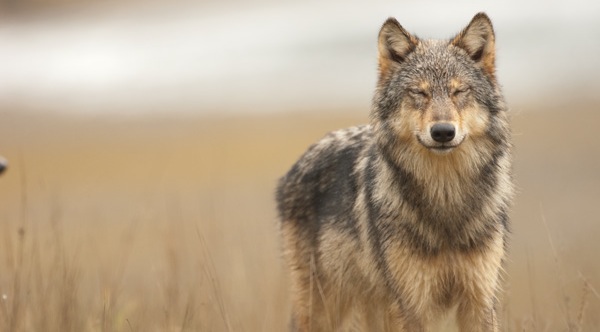
This wolf is just growing his new coat in preparation for a long, dark and wet winter. Because of the relatively mild climate on the BC coast, rainforest wolves grow a thick winter coat for only a short period of time.
It’s certainly true that wolves are efficient hunters. So if you’re ever in a part of the forest where wolves live, you have to be wary of them. But wolves also demonstrate many other characteristics—characteristics people must have recognized and admired long ago. Why? Because it was from the wild wolf that the domestic dog was born 12,000 to 14,000 years ago. That’s right, without the wolf we never would have been introduced to “man’s best friend.” Whoever took in the first wild wolf and made him or her a companion to be loved, not feared, must have recognized a certain kinship between people and wolves. Those people must have seen how much wolves enjoyed being with other wolves, just as today’s dogs enjoy being with other dogs and people. Of course, many of the dogs we live with today look nothing like wolves. That’s thanks to years of careful and selective breeding. At the same time there are other breeds, like the German shepherd, the husky and the malamute, where the resemblance is as plain as the snouts on their faces. But even though the cockapoo or labradoodle might not look it, they have some wolf in them too. Why do you think dog trainers sometimes refer to domestic dogs as “the wolf in your living room”?
The wolves we’re talking about in this book are from a unique population living along the west coast of British Columbia in an area known as the Great Bear Rainforest. This area got its name because of the great bears—the American blacks, grizzlies and spirit bears (a black bear with white fur)—who live there too. But it would be a mistake to think that the rainforest, which extends from the top of Vancouver Island to the tip of Alaska’s Panhandle and inward from the Pacific Ocean to the Coast Mountains, is home to nothing but bears. Hundreds of other animals—moose, cougars, mountain goats, deer, whales, seals, sea lions, toads, reptiles, myriad birds, and who knows how many different kinds of insects—live there too.

This yawning wolf pup shows the size of its jaws and why wolves are such efficient hunters. An adult wolf can bite a deer leg in half with its powerful mouth. Its jaw is more than twice as powerful as that of a domestic dog.
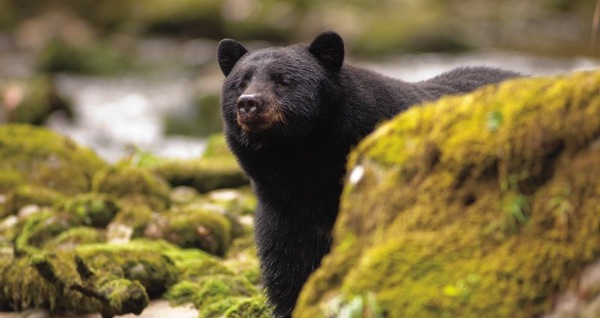
The Great Bear Rainforest is full of black bears, but they have to be on guard all the time because wolves may attack them. Even adult bears may be hunted by wolves.
So do wolves. But these wolves are different from their inland cousins; these wolves can swim like otters and fish like bears. They’re called coastal wolves because they live near the sea. For aboriginal, or First Nations, people who have shared the land with them for generations, they’re as much a part of the land- and seascape as the grizzly, the salmon and the killer whale. But it’s only recently that scientists have come to understand their uniqueness: that they are genetically distinct from wolves in the interior of British Columbia, and different from any other wolf in any other part of the world.
One of the differences between coastal wolves and wolves on the other side of the Coast Range, a spine of mountains that runs along the western edge of British Columbia, is that they’re smaller. In fact, they are about 20 percent smaller. That makes them roughly the size of a long-legged German shepherd dog. Why the difference? Science’s best guess is that warmer temperatures on the coast mean the wolves who live there don’t have to grow larger. A general rule of nature is the colder the environment, the larger the animal. Why? Think about it: skinny people tend to get cold faster than heavyset people because they carry less “padding.” Or put another way, heavyset people pack a lot more insulation. The same is true of wildlife. This probably explains why polar bears in the Arctic and tigers in Siberia grow much larger than bears and tigers in warmer places.

This wolf has a porcupine quill lodged in his nose—the painful consequence of trying to hunt the sharp-quilled creature. There are risks attached to hunting just about any animal, and wolves have to weigh these every time they head off in search of prey.
This notion of being only as big as you need to be prevails throughout nature. That’s because nature, unlike the communities humans build, is a very energy-efficient place. Just as the fuel that heats your home or runs your car isn’t limitless, neither is the energy in nature. It comes from the food animals and plants eat. And because there’s only so much food to go around, nature has created ways for it to be used efficiently. One of these ways is for animals like wolves to grow no bigger than they have to.
Another difference between coastal and inland wolves is that the coastal wolf’s fur is coarser and less dense than his inland cousin’s. This also makes sense from an energy-saving perspective because it doesn’t get as cold on the coast as it does inland. So regardless of whether you’re a wolf or a person, you don’t need as thick a coat. And while inland wolves are mostly silver gray in color, many coastal wolves have a distinctive rust red hue. In fact, many are multicolored—they have ocher and sepia on their ears and back, and black and silver or white down their sides. But almost all of them have a special red tint all their own.
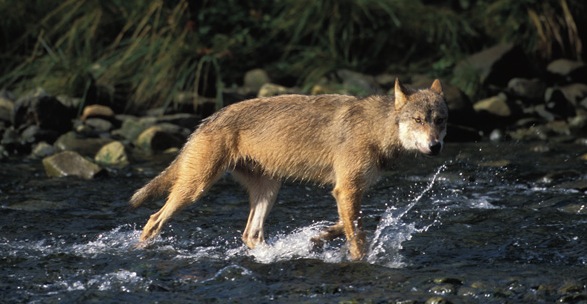
Rainforest wolves are slightly smaller than their gray wolf cousins, who live in the far north and interior of North America. This pale brown wolf splashing his way through a river has just shed his winter coat, so he looks particularly thin.
Another big difference between the two types of wolves is that coastal wolves swim—a lot. And if that surprises you, think of your dog. Certain breeds of dogs like Labradors and spaniels love swimming and are very good at it. Well, so are BC’s coastal wolves. Some have been known to swim distances as great as thirteen kilometers (eight miles). That’s almost five times the length of the Golden Gate Bridge in San Francisco. The fact that these wolves are such good swimmers makes good sense. When you stop to think about it, that’s true of almost everything in nature. Off the coast of the Great Bear Rainforest there are hundreds of big and small islands and many more lakes, rivers, streams, bays and inlets. Surrounded by all this water, coastal wolves have to get around somehow. Boats aren’t an option, so what else is there but swimming? They swim from island to island to find the deer, salmon and other animals they survive on. And if they find a seal, a beached whale or another kind of marine mammal along the way, they’ll eat it too. When fall arrives, they also fish for salmon that swim up the rivers to spawn and die. An old Russian proverb says “The wolf is kept fed by his feet.” In BC’s coastal forest, their feet help them swim too.

Coastal wolves in the Great Bear Rainforest are genetically distinct. This means their genetic makeup is different from other wolf populations, including other wolves living elsewhere in North America. They also look different from their inland cousins. They’re slightly smaller, and they have more red in their coats.
But perhaps the most amazing thing about these coastal wolves is that for as long as they’ve been around, they’ve lived among people who not only don’t hate them but actually value them. The people of the Great Bear Rainforest have never sought to hurt or punish wolves. Instead these First Nations people have always believed wolves have as much right to a place in the world as human beings. In most other places where wolves are found—from Russia to the Rockies—they’ve been persecuted by humans with a kind of madness. Not in the Great Bear Rainforest. The GBR is one place in the world where wolves have been allowed to live in comparative harmony with humans. When European settlers came to British Columbia in the nineteenth and twentieth centuries, that began to change. But even then, because the Great Bear Rainforest is so difficult to get to and so far away from places where immigrants built their cities and towns, coastal wolves remained fairly well protected.
This book tells their story. It will explain that rather than the big, bad, grandmother-swallowing beasts of European folklore, the wolves of coastal British Columbia are creatures to cherish and admire. Yes, they are hunters, but that’s how they fit into nature and help maintain her balance. Like the great bears who give the rainforest its name, the wolves are a magnificent rainforest symbol: brave, loyal, resourceful and clever. Creatures who deserve our care, our respect and our protection, just like any other natural treasure.
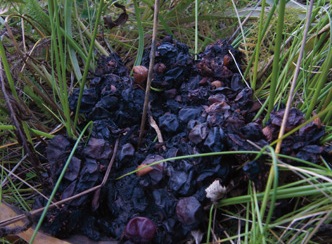
The round pink objects in this wolf scat are evidence of salal berries in the wolf’s diet. While wolves are dedicated carnivores, meaning they eat fish and meat for almost all their calories, they also will eat grass, berries and other foods on occasion.
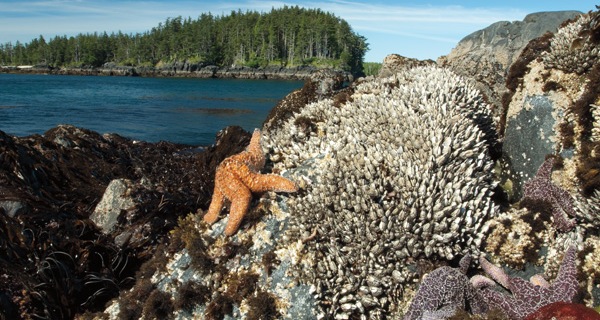
The Great Bear Rainforest is defined as much by the sea as by the land, and coastal wolves are at home in both. When the tide goes out, an assortment of brightly colored marine life becomes visible along the rocky shoreline—marine life that wolves will eat. Wolves don’t rely on crabs, barnacles and mussels for a big part of their diet, but when you’re as hungry as a wolf, you’d be foolish to turn down an easy-to-catch meal.